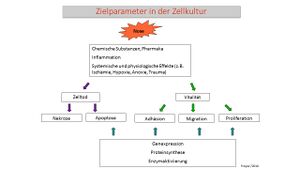PREMIER Target Parameter
Definition of the Target Parameters
Parameter is a characteristic that can help to define or classify a particular population. Target parameter is any parameter that we want to estimate. By defining suitable target parameters, the significance / quality and efficiency of the project can be ensured. A distinction is made between primary and secondary target parameters, which must be checked in advance for relevance and validity.
Relevance
- Do the target parameters match the question posed?
- Are the target parameters scientifically and clinically significant?
Validity
- Are there any target parameters at all?
- How many target parameters are there?
- How are the target parameters measured?
- How valid are the measuring instruments used?
The inclusion and exclusion criteria for the target parameters must be defined in the model planning..
Target Parameters / Target Size
By defining suitable measurement and target parameters, quality and efficiency of the research process can be controlled. Recording many parameters without reflection does not increase the quality of the experiment, but can lead to a bias if the results are evaluated afterwards.
Besides the definition of clear target parameters, their technical implementation suitable for everyday use is essential.
A target parameter must be validated so that a reliable and reproducible statement can be made for the research process. An ideal target parameter would be sensitive and robust. Preliminary tests should be carried out to validate the test setup. The use of "historical" results can complement or, under certain conditions, replace these preliminary tests.
Primary / Secondary Target Parameters
The primary target parameter (main target variable) is the most important parameter and represents the criteria of the study objective. With its help it can be determined whether the applied experimental measures (e.g. a treatment or genetic factors) were successful. The effect of the experimental measures can also be reflected by two or more main outcome measures. In the experiment, the target parameters established before the start of the study are then compared in the treated group with those of the control group.
Secondary target parameters should be supportive for the primary target parameters. Several secondary target parameters can lead to more reliable results.
Target Parameters in vitro / in vivo
In vitro
Target parameter cell culture:
- cell death -> necrosis vs. apoptosis
- vitality: adhesion, migration, proliferation
- gene expression
- protein synthesis
- enzyme activation
How these are connected to each other is shown in this figure:
Quantification of the Target Parameters
Various methods are available for the quantification of the target parameters. Which method is used depends on:
- the measuring equipment that is available
- the desired measuring accuracy
- the amount of cells available
Some examples are given below:
Cell Death
- LDH assay: release of lactadehydrogenase into the cell culture supernatant
- MTT assay: measures the metabolic activity of the cell culture via the conversion of tetrazolium blue to formazan in the mitochondria
- Crystal violet staining: non-specific staining of intracellular proteins
Proliferation
- MTT assay: measures the metabolic activity of the cell culture via the metabolism of tetrazolium blue to formazan in the mitochondria
- BrdU: uptake of bromodeoxyuridine into the DNA of dividing cells
In vivo
Select target parameter in vivo: Target parameters that can be measured directly and objectively are preferably not relative scores but numerical units of measurement.
Important: Validation of the desired parameters to ensure a causal relationship with the method used.
State according to MCAO
Example:
- survival
- infarct size, histological and/or MRT
- body weight and body weight change according to MCAO
Functional Outcome
- General and stroke-related illness behaviour: Neuroscore
- Behavioural parameters, such as turns in the corner test or duration of stay on the Rota-Rod
- Parameters for inflammation or infection: Cytokine level, blood count
References
- University of California, Davis Department of Statistics. 5.1 Identifying the Target Parameter. Lecture 5: Estimation with Confidence intervals.
